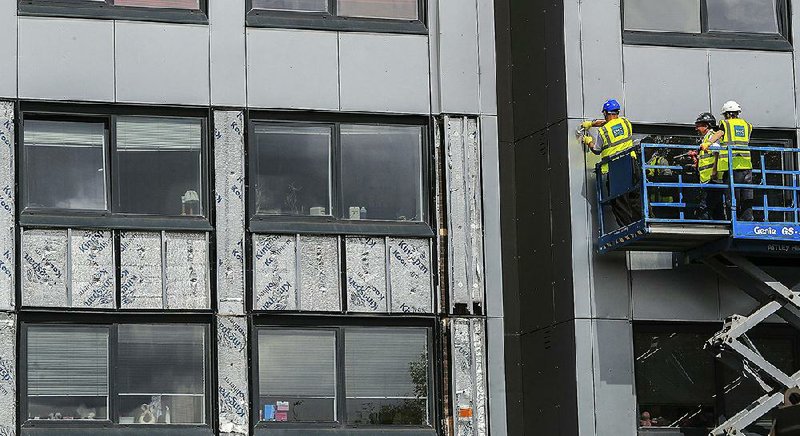LONDON -- When a short-circuiting fridge transformed London's 24-story Grenfell Tower from a home for hundreds to a charred ruin, officials described it as a horrific anomaly -- an "unprecedented" blaze, in the words of the city's fire commissioner, the likes of which had not been seen in modern Britain.
Click here for larger versions
Photos by The Associated Press
Photos by The Associated Press
But now, after nearly two weeks, dozens of failed safety inspections and the hurried evacuation of thousands of public housing residents, Grenfell is looking like something else entirely: a dire warning.
The blaze that claimed at least 79 lives -- residents say the true toll is far higher -- has prompted tests that point to an epidemic of flammable exterior cladding on high-rise buildings across the country.
Of the 75 buildings tested so far, a senior government minister said Monday, 75 have failed fire safety tests -- up from 60 out of 60 on Sunday.
Far from being an isolated case, critics say, Grenfell was symptomatic of a loose regulatory system that allowed as many 600 residential towers to be encased in a material that helps spread flames, rather than stop them.
For the cash-strapped local councils that manage the buildings -- and for the tens of thousands of residents who live in them -- the revelations have brought agonized choices: Evacuate without a plan for where people should go next, or allow them to stay and risk another Grenfell?
"Everyone is absolutely terrified," said Kathleen Hughes, who cares for her husband, an Alzheimer's patient, on the seventh floor of a north London high-rise that is wrapped in a similar cladding to that found at Grenfell. "There are a lot of children on that top floor. We have one staircase."
Her building has not been evacuated, and she said that despite her fears, she hopes it isn't. "I'm 75 for God's sake," she said. "I don't need all of this on top of what I got."
For the British government, rapidly growing evidence of the true scale of the problem has brought a different kind of question, but one that's no less difficult: Why was a type of cladding that was long banned on high-rises in the United States and continental Europe permitted to be used on towers in the U.K.?
The maker of the cladding -- the U.S.-based successor to metals giant Alcoa, which is now known as Arconic -- said Monday that it was pulling the product worldwide from use on tall buildings.
"We believe this is the right decision because of the inconsistency of building codes across the world and issues that have arisen in the wake of the Grenfell Tower tragedy," the firm said in a statement.
The type of cladding, known as Reynobond PE, has sheets of aluminum surrounding a flammable plastic core. It's cheaper than a fire-resistant version, also sold by Arconic, that has metal in place of the plastic.
British investigators have said the Grenfell blaze began when a fridge in a fourth-floor apartment caught fire, which then rapidly climbed the building's exterior, using the cladding and insulation as fuel. The building was consumed in flames within minutes, and it burned for days.
The British government said last week that as many as 600 high-rise buildings could have similar types of cladding and need to be tested. But so far, only a fraction have been.
"We would say to all landlords out there, please urgently send those samples in," Housing Minister Alok Sharma told the BBC on Monday.
In a statement to Parliament later Monday, minister for communities Sajid Javid said private landlords should also send in samples for the government to test. Until Monday, the tests were focused exclusively on public housing.
Safety checks were continuing on the cladding on high-rise buildings across the country. Sian Berry, a member of the Camden Council which evacuated several high-rise buildings over the weekend, said the decision to test buildings was voluntary and was being decided by local authorities based on individual risk assessments.
She said that because all the tower blocks tested so far had failed, questions were being raised that even cladding deemed to be safer than that which had been used at Grenfell may not meet fire safety standards.
"Councils who can't tell if cladding is safe from the paper trail or just by looking at the building are sending them out for testing, and people are being cautious," she said. "The results so far are alarming."
John McDonnell, the opposition Labor Party's spokesman on economic issues, said those killed in Grenfell Tower had been "murdered" by "political decisions" made over recent decades.
As many across the political spectrum have criticized the regulatory shortcomings that may have led to the Grenfell fire, members of the insurance industry have said they warned the government about the risks of flammable cladding just a month before it happened.
Information for this article was contributed by Griff Witte and Karla Adam of The Washington Post; and by Dan Bilefsky and Zephira Davis of The New York Times.
A Section on 06/27/2017
